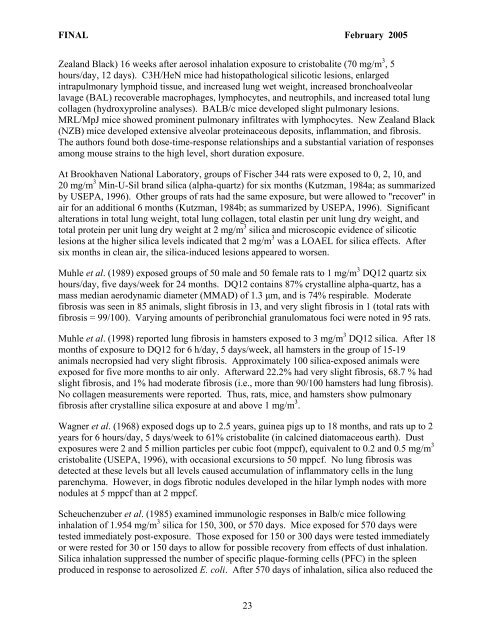Silica (crystalline, respirable) - OEHHA
Silica (crystalline, respirable) - OEHHA
Silica (crystalline, respirable) - OEHHA
Create successful ePaper yourself
Turn your PDF publications into a flip-book with our unique Google optimized e-Paper software.
FINAL February 2005<br />
Zealand Black) 16 weeks after aerosol inhalation exposure to cristobalite (70 mg/m 3 , 5<br />
hours/day, 12 days). C3H/HeN mice had histopathological silicotic lesions, enlarged<br />
intrapulmonary lymphoid tissue, and increased lung wet weight, increased bronchoalveolar<br />
lavage (BAL) recoverable macrophages, lymphocytes, and neutrophils, and increased total lung<br />
collagen (hydroxyproline analyses). BALB/c mice developed slight pulmonary lesions.<br />
MRL/MpJ mice showed prominent pulmonary infiltrates with lymphocytes. New Zealand Black<br />
(NZB) mice developed extensive alveolar proteinaceous deposits, inflammation, and fibrosis.<br />
The authors found both dose-time-response relationships and a substantial variation of responses<br />
among mouse strains to the high level, short duration exposure.<br />
At Brookhaven National Laboratory, groups of Fischer 344 rats were exposed to 0, 2, 10, and<br />
20 mg/m 3 Min-U-Sil brand silica (alpha-quartz) for six months (Kutzman, 1984a; as summarized<br />
by USEPA, 1996). Other groups of rats had the same exposure, but were allowed to "recover" in<br />
air for an additional 6 months (Kutzman, 1984b; as summarized by USEPA, 1996). Significant<br />
alterations in total lung weight, total lung collagen, total elastin per unit lung dry weight, and<br />
total protein per unit lung dry weight at 2 mg/m 3 silica and microscopic evidence of silicotic<br />
lesions at the higher silica levels indicated that 2 mg/m 3 was a LOAEL for silica effects. After<br />
six months in clean air, the silica-induced lesions appeared to worsen.<br />
Muhle et al. (1989) exposed groups of 50 male and 50 female rats to 1 mg/m 3 DQ12 quartz six<br />
hours/day, five days/week for 24 months. DQ12 contains 87% <strong>crystalline</strong> alpha-quartz, has a<br />
mass median aerodynamic diameter (MMAD) of 1.3 µm, and is 74% <strong>respirable</strong>. Moderate<br />
fibrosis was seen in 85 animals, slight fibrosis in 13, and very slight fibrosis in 1 (total rats with<br />
fibrosis = 99/100). Varying amounts of peribronchial granulomatous foci were noted in 95 rats.<br />
Muhle et al. (1998) reported lung fibrosis in hamsters exposed to 3 mg/m 3 DQ12 silica. After 18<br />
months of exposure to DQ12 for 6 h/day, 5 days/week, all hamsters in the group of 15-19<br />
animals necropsied had very slight fibrosis. Approximately 100 silica-exposed animals were<br />
exposed for five more months to air only. Afterward 22.2% had very slight fibrosis, 68.7 % had<br />
slight fibrosis, and 1% had moderate fibrosis (i.e., more than 90/100 hamsters had lung fibrosis).<br />
No collagen measurements were reported. Thus, rats, mice, and hamsters show pulmonary<br />
fibrosis after <strong>crystalline</strong> silica exposure at and above 1 mg/m 3 .<br />
Wagner et al. (1968) exposed dogs up to 2.5 years, guinea pigs up to 18 months, and rats up to 2<br />
years for 6 hours/day, 5 days/week to 61% cristobalite (in calcined diatomaceous earth). Dust<br />
exposures were 2 and 5 million particles per cubic foot (mppcf), equivalent to 0.2 and 0.5 mg/m 3<br />
cristobalite (USEPA, 1996), with occasional excursions to 50 mppcf. No lung fibrosis was<br />
detected at these levels but all levels caused accumulation of inflammatory cells in the lung<br />
parenchyma. However, in dogs fibrotic nodules developed in the hilar lymph nodes with more<br />
nodules at 5 mppcf than at 2 mppcf.<br />
Scheuchenzuber et al. (1985) examined immunologic responses in Balb/c mice following<br />
inhalation of 1.954 mg/m 3 silica for 150, 300, or 570 days. Mice exposed for 570 days were<br />
tested immediately post-exposure. Those exposed for 150 or 300 days were tested immediately<br />
or were rested for 30 or 150 days to allow for possible recovery from effects of dust inhalation.<br />
<strong>Silica</strong> inhalation suppressed the number of specific plaque-forming cells (PFC) in the spleen<br />
produced in response to aerosolized E. coli. After 570 days of inhalation, silica also reduced the<br />
23















